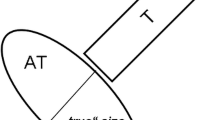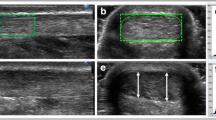Abstract
Objective
To evaluate the test-retest reliability of the ultrasound echo intensity parameters on healthy Achilles tendon using a semi-automatic tracing procedure.
Materials and methods
Eighteen healthy volunteers participated. B-mode images were acquired in the transverse plane (mid-tendon; insertion) and used to analyze tendon echogenicity. Grayscale distribution of the pixels within the selected ROIs was represented as a histogram. Descriptive statistics of the grayscale distribution (mean, variance, skewness, kurtosis, and entropy) and parameters from the co-occurrence matrix (contrast, energy, and homogeneity) were calculated.
Results
Reliability of echo intensity parameters of the mid-Achilles tendon ranged from high to very high with an ICC2.k of 0.94 for echogenicity, 0.87 for variance, 0.80 for skewness, 0.72 for kurtosis, 0.89 for entropy, 0.90 for contrast, 0.91 for energy, and 0.93 for homogeneity, while for tendon insertion they ranged from moderate to high with an ICC2.k of 0.74 for echogenicity, 0.88 for variance, 0.75 for skewness, 0.55 for kurtosis, 0.87 for entropy, 0.70 for contrast, 0.77 for energy, and 0.56 for homogeneity.
Conclusion
Ultrasound echo intensity is a reliable technique to characterize the internal structure of the Achilles tendon.


Similar content being viewed by others
References
Astrom M, Gentz CF, Nilsson P, Rausing A, Sjoberg S, Westlin N. Imaging in chronic achilles tendinopathy: a comparison of ultrasonography, magnetic resonance imaging and surgical findings in 27 histologically verified cases. Skelet Radiol. 1996;25:615–20.
Maffulli N, Almekinders L. The Achilles tendon, vol. xiv. London: Springer; 2007. p. 284.
Maffulli N, Kenward MG, Testa V, Capasso G, Regine R, King JB. Clinical diagnosis of Achilles tendinopathy with tendinosis. Clin J Sport Med. 2003;13:11–5.
Kannus P. Etiology and pathophysiology of chronic tendon disorders in sports. Scand J Med Sci Sports. 1997;7:78–85.
Mahieu NN, Witvrouw E, Stevens V, Van Tiggelen D, Roget P. Intrinsic risk factors for the development of achilles tendon overuse injury: a prospective study. American J. Sports Med. 2006;34:226–35.
Chimenti RL, Flemister AS, Tome J, et al. Altered tendon characteristics and mechanical properties associated with insertional achilles tendinopathy. J Orthop Sports Phys Ther. 2014;44:680–9.
Arts IM, Pillen S, Schelhaas HJ, Overeem S, Zwarts MJ. Normal values for quantitative muscle ultrasonography in adults. Muscle Nerve. 2010;41:32–41.
Strasser EM, Draskovits T, Praschak M, Quittan M, Graf A. Association between ultrasound measurements of muscle thickness, pennation angle, echogenicity and skeletal muscle strength in the elderly. Age. 2013;35:2377–88.
Wang JH, Hung CH, Kuo FY, et al. Ultrasonographic quantification of hepatic-renal echogenicity difference in hepatic steatosis diagnosis. Digest Dis Sci. 2013;58:2993–3000.
Xia MF, Yan HM, He WY, et al. Standardized ultrasound hepatic/renal ratio and hepatic attenuation rate to quantify liver fat content: an improvement method. Obesity. 2012;20:444–52.
Collinger JL, Fullerton B, Impink BG, Koontz AM, Boninger ML. Validation of grayscale-based quantitative ultrasound in manual wheelchair users: relationship to established clinical measures of shoulder pathology. Am J Phys Med Rehabil. 2010;89:390–400.
Nadeau MJ, Desrochers A, Lamontagne M, Lariviere C, Gagnon DH. Quantitative ultrasound imaging of Achilles tendon integrity in symptomatic and asymptomatic individuals: reliability and minimal detectable change. J Foot Ankle Res. 2016;9:30.
Collinger JL, Gagnon D, Jacobson J, Impink BG, Boninger ML. Reliability of quantitative ultrasound measures of the biceps and supraspinatus tendons. Acad Radiol. 2009;16:1424–32.
Kjaer M, Langberg H, Heinemeier K, et al. From mechanical loading to collagen synthesis, structural changes and function in human tendon. Scand J Med Sci Sports. 2009;19:500–10.
Pingel J, Harrison A, Simonsen L, Suetta C, Bulow J, Langberg H. The microvascular volume of the Achilles tendon is increased in patients with tendinopathy at rest and after a 1-hour treadmill run. American J Sports Med. 2013;41:2400–8.
Carcia CR, Martin RL, Houck J, Wukich DK. Orthopaedic section of the American physical therapy a. Achilles pain, stiffness, and muscle power deficits: achilles tendinitis. J Orthop Sports Phys Ther. 2010;40:A1–26.
Walter SD, Eliasziw M, Donner A. Sample size and optimal designs for reliability studies. Stat Med. 1998;17(1):101–10.
Munro BH. Statistical methods for health care research. 5th. Philadelphia, Penn. London: Lippincott Williams & Wilkins; 2005.
Chinn S. The assessment of methods of measurement. Stat Med. 1990;9:351–62.
Atkinson G, Nevill AM. Statistical methods for assessing measurement error (reliability) in variables relevant to sports medicine. Sports Med. 1998;26:217–38.
Bharati MH, Liu JJ, Mac Gregor JF. Image texture analysis: methods and comparisons. Chemometr Intell Lab. 2004;72:57–71.
Castellano G, Bonilha L, Li LM, Cendes F. Texture analysis of medical images. Clin Radiol. 2004;59:1061–9.
Author information
Authors and Affiliations
Corresponding author
Ethics declarations
Conflict of interest
The authors declare that they have no conflict of interest.
Ethical approval
All procedures performed in studies involving human participants were in accordance with the ethical standards of the institutional and/or national research committee and with the 1964 Helsinki Declaration and its later amendments or comparable ethical standards.
This study was approved by the Ethics Committee of Canton Ticino, registration no. 2752.
Rights and permissions
About this article
Cite this article
Schneebeli, A., Del Grande, F., Vincenzo, G. et al. Test-retest reliability of echo intensity parameters in healthy Achilles tendons using a semi-automatic tracing procedure. Skeletal Radiol 46, 1553–1558 (2017). https://doi.org/10.1007/s00256-017-2748-9
Received:
Revised:
Accepted:
Published:
Issue Date:
DOI: https://doi.org/10.1007/s00256-017-2748-9




